A rare gardener, who once saw Hauttynia, does not arise a desire to plant this original plant in the garden. Sometimes some difficulties often arise in the process of cultivation of Houttynia. To avoid this, use the rules for growing this culture and care.
Houttynia, cultural description
The unusual name of Houttynia is perfectly harmonized with a bizarre and colorful appearance of the plant. In ordinary gardens, it is not so popular as other decorative cultures. But recently, interest in her decorative magnificent foliage, which quickly and confidently grows up significantly increased.
Modest and winter-hardy varieties of Houttynia form the family of the Savron family. In a natural habitat, the plant is considered weed that clogs rice and tea plantations. The area of \u200b\u200bgrowth is limited to the southeastern regions of Asia, so it is possible to meet Houttynia in a wild form. It is possible that in Asian countries, for example, in Japan and Himalayas. There, Houttynia is often cultivated in culture, but only as an edible plant with a useful greens and rhizome.
- Houttynia is a long-term grassy culture with a white rhizome, from which there are many thin flames of the cordless form. They occupy a horizontal position and rarely germinate below the surface ball of the soil.
- The above-ground part of Houttynia form numerous red color stalks. Their height varies between 25 and 40 cm.
- Houttynia is not an evergreen culture and when the air temperature is omitted below zero, the whole foliage is popped.
- The leaves of the Asian perennial numerous, externally resemble a lime leaf and have a heart-shaped form. The color of the leaf is motley, the bulk is set red, green, white paints. It is the colorful foliage and ensures the decorativeness of Houttynia.
- Flowers hawtynia beauty do not differ. They are sufficiently small, unsightly, resemble calla. There may be an ordinary or terry structure. A cream shade with five petals continues miniature pillars, dense yellow flower. Inflorescence Houttynia is a single, accositious form.
- Chauttyunia blossom abundant and long. The active phase of flowering falls on the second half of summer.
- The view of Houttuynia Cordata (core) has several colorful varieties that are well evolving in the areas of the middle strip.
- Houttynia varieties are found in the originality of the color of foliage, which can play red, fiery, creamy white and pink paints. Leaves can be weathered and monophonic, like a heart-shaped hauttynia main species. But more attractive is the motley leaves with smoothly erosion of different shades, like Houttynya Chameleon.
Interesting varieties of Houttynia
Great interest among the gardeners causes voyage varieties of Houttynia. Special decorative among them differ as follows:
- houttynia Pied Piper - in the people of this kind called the tricolor. The color of greenery forms one basic tone - green, and fermented yellow and white color. In very shaded places, the tricolor can completely lose decorative, increasing the dark green hat;
- houttynia Chameleon is the most demanded variety with the leaves-chameleon. They are under the influence of the sun know how to change their color: in dark places, the leaflets become beige-green, and in sunny areas "dressed" in the red-malachite outfit. Flowers at the grade cream-white, small, are located in one row. Depending on the desired color of the Kustyunia Hameleon, the landing is carried out on a suitable area;
- houttynia Plena is a modest variety with a poor coloring. Its leaves are transferred by blue and green paints, which complement the delicate terry inflorescences with a multi-level location of snow-white petals;
- houttynia Variegata is a motley grade with colorful grace of foliage. With sufficient lightening, a lineral hat acquires a mixture of red, fiery, pink, bright green. All shades like watercolor spread along the sheet, creating a multifaceted color. Flowering in variety is scanty: only occasionally single four-lines of cream flowers are noticeable.
Interesting! In some regions, China discovered another kind of Houttynia called Emeiensis (Houttunyia Emeiensis). At the moment, the official description and classification of this plant is not yet.
Houttynia, landing and care
Houttynia in the natural environment is a resident of wet and sunshine. Therefore, before it landing should be well thought out where to plant it so that there are no many difficulties in caring for Hauttynia in the future.
Choosing a place on the site for Houttynia
Although Houttynia fell into our gardens from several other climatic conditions, where the winter is not so severe and long, it mastered perfectly due to its frost resistance. It does not present special requirements for growing conditions. But you still need to pay attention to some nuances.
- The first thing to start, this is a choice of place in the garden. It should be sunny, without high shading, where sunlight is available at least 5 hours a day. Especially carefully need to go to the selection if you have a damp variety. So, for Houttynya chameleon, landing and care for which it causes the greatest difficulty, you need to choose the right place in the garden. If you make an error, you can completely ruin the decorativeness of the plant.
- The soil for Houttynia is suitable, drained. The substrate can be humulating, loamy-peat. The plant is equally rooted in the overexposed soil, and on stony areas. The main thing is to avoid high nitrogen content in the ground, which significantly reduces the frost resistance of Houttynia.
- The deliberate choice will be shallow water. Havoutyunia can be planted along the rivers nearby artificial reservoirs. But you can grow hawtynia and on a simple land plot or even on a rocky elevation, you just have to provide a plant frequent and abundant watering.
- It is important for Houtty and Temperature Mode. In the hot time, it can take an increased temperature only with sufficient moisture. In the winter season, Houttynia is able to withstand to -25⁰, if it winter with a good shelter with snow shaft or synthetic material. Without proper shelter, the plant dies when the temperature is omitted to -18 ° C.
Features of boarding hauttynia
You can buy seedlings in a specialized nursery for landing Houttynia. Young seedlings are very easily rooted in a new place and quickly capture the neighboring sites that need to be taken into account until they are planted into the ground. To reduce the aggressiveness of the Khauttynia root system, which is able to exhibit all the neighboring plants, it is necessary to limit the territory of its expansion.
- Since in the soil of Houttynia does not germinate deeply, limit the root system will help the landing of it in a bucket without a bottom or a conventional tire. You can also build a shallow barrier from cut plastic containers. Write them more than 25 cm do not need. Or as one more option, you can use regular cutting with a shovel of the roots of Houttynia around the perimeter of the entire bed.
- It is possible to plant Houttynia in shallow water, but it is advisable to do it in a basket, which together with the plant can be removed from the reservoir before frosts. In winter, you can store a container with Houttyunia in a cool cellar.
- When planning the garden, it should be remembered that Houttynyy is sitting in the soil for a long time and only in the second half of May begins to show activity. Using such a feature of the plant, you can land in its place the primroses so that the garden plot is not empty for a long time.
- Havoutyunia landing in the soil of difficulties does not create. Young bushes are immersed in a suitable primer to a depth of 10-15 cm. Then the plant is abundantly watered. If the landing is carried out in conventional soil, a good clay drainage is necessarily provided and the subsequent abundant soil moisturizing. As a rule, Houttynia is rapidly growing, creating a chic motley carpet in the garden.
Hauttynia, garden care
Houttynia will not require a lot of attention if it is planted in a good wet place. The only thing that will be needed is to prevent the soil drying, rare feeding and shelter for the winter. Therefore, even the most capricious grade Houtyunia is chameleon, growing and care for which is more complex, does not deliver the troubles of both an experienced gardener and a newcomer.
Watering and feeding Hautty
- This Asian beauty needs a lot of moisture. Therefore, it will be almost daily in hot weather. Increase the soil moisture in the coastal circle of Houttynia will help the wet compost, which can be scattered near the plant. The exception is Houttynia, planted near the reservoir. In this case, such frequent watering will be superfluous.
- Houttynia subject is carried out using special fertilizers. A bone, horny or phosphate flour is often used, which is not dissolved in the liquid. It is enough just to pour flour near Hauttynia, and it will gradually saturate the plant with the necessary minerals.
- You can also fertilize Houttynia mineral granules with a resin sheath. In the spring, they are distributed around the plant, and throughout the summer season, they gradually penetrate the root system, hauttynia.
- It will be quite suitable for feeding and other complex mineral formulations in the form of powder, the main thing is that there are no many nitrogen in them, which provokes the rotor of the Houtyunia roots.
Trimming and wintering hauttynia
- Protecting plants spend in spring. If Houttynia is too rummaged, unnecessary roots are partially cut. In the second half of the spring, cuttings are cut for breeding. In the summer, it is not necessary to trim shoots. Houttynia is beautifully expanding and to maintain decorativeness cutting green carpet do not spend.
- The preparation of Houttynia to the cold is to collect fallen foliage and the construction of the shelter. If the plant is planted in the regions with a small amount of snow, the bush is covered with sawdust, coniferous branches or special coating material.
- You can also plant hauttynia to the container and along with it to plant a plant on the breast. With the onset of cold weather, the container is simply removed into the cellar or garage.
Houttynia heart-shaped, reproduction
Get new Khauttynia bushes makes it easy to divide the rhizomes or rooting of the cuttings obtained after the spring trimming of the plant.
GUATTUNIENIE DISPLATION ROINVE
Havoutyunia's pavement is carried out in early spring, so that young bushes are rooted before the onset of frost. Plugulation of the plant in this way:
- Before the beginning of the vegetative period, a small layer of soil is carefully removed, under which Houttynia's roots are hidden.
- Rhizome is considered on the subject of nodules. When the appropriate nodule is detected, it is cut off with a part of the root.
- Then the shovel is elevated under the root, gently raise it and pull.
- The spine is eliminated from the earthen coma and plant in the container with the prepared soil (it should be enriched with sand, peat, clay).
- The root is immersed to a depth of 10 cm, buried, pour themselves.
- After the appearance of the first leaves, the bush landed on the bed (you can, along with the pot).
The reproduction of Houttynia Chernoka
The billet of the cuttings is carried out closer to the summer, when their height is at least 5-7 cm. If the cuttings are cut closer to autumn, their rooting is carried out at home. The cuttings are cut with several healthy leaflets, the length of each stem must be 3-5 cm. After that, rooting is carried out:
- Take a container in the form of a glass or bowl and fill with water by 1/3 volume.
- Then plunge the cut there. If the stalks with leaves are put in a bright place, if without them, you can leave the tank in the shade.
- Constantly monitor the evaporation of moisture and regularly fill water into the container.
- When the roots are shown, the cuttings are planted into the soil. The depth of planting is 10 cm.
- At this stage, you can land the rooted cuttings immediately on the bed.
Diseases and pests hauttynia
Like other plants growing near the reservoirs, Houttynia may be affected by many pests:
- Komar-Cricotopus - his larvae spoil the leaves that serve for them.
- Water fire - small caterpillars, eating greenery.
- Moth - red worms that can significantly damage the root system.
- The cerebrika - yellow caterpillars tear down holes in the leaves and flowers, reducing decorativeness.
- The wave and midges are small insects, damaging the above-ground part of the plant.
Important! Houttynia, which grows in the usual garden without reservoirs, is not damaged by such pests. However, this does not mean that slippers and notes will not be able to damage her delicious leaves.
From Houthetynia diseases can affect root rot and spotty. Such diseases are developing with improper leaving of the plant. To cure the infected hauttynia will help the normalization of watering, good drainage and trimming of damaged parts.
Useful Houttynia, Application
Houttynia is often used as a food product. Greenery is added to salads, rootflood - in fish dishes, side dishes. But its specific fish fragrance with mint notes is popular only in China and Vietnam.
Apply Houttynia and folk healing. It is based on medicinal products for treatment:
- hemorrhoids;
- swelling;
- purulent wounds;
- cough;
- reduced immunity.
Toning, antipyretic and anti-inflammatory properties of Houttynia are used to prepare common and restoring drinks.
Houttynia in landscape design
Houttynia, reviews of which are more positive, is an important element of the general design of the garden. In landscape design, this plant occupies a special place and is one of the most sought-after cultures for the design of water bodies.
Houttynyia quickly forms a colorful green carpet, closing all empty parts of the garden, coastal areas, steps of artificial ponds, limited flower beds. Houttynia is grown on flowerbed, in decorative vases, in mountaineering and rockers. It can be successfully combined with low coniferous cultures, cereals, roses, strambed dwarf trees, samshets, spicy herbs.

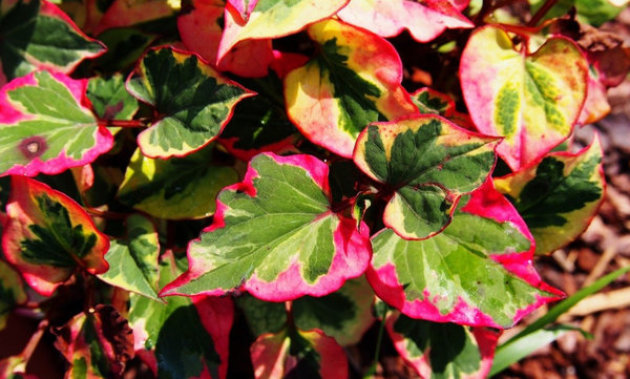
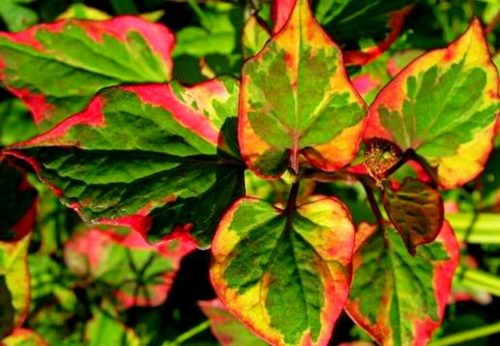
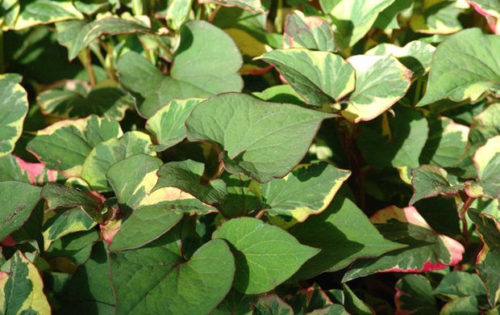
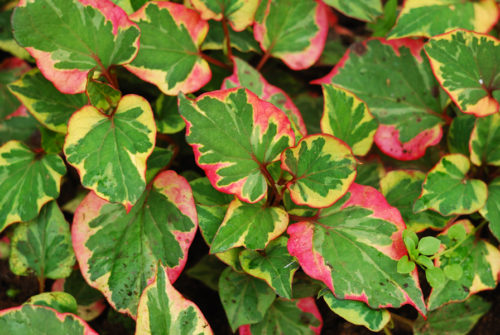
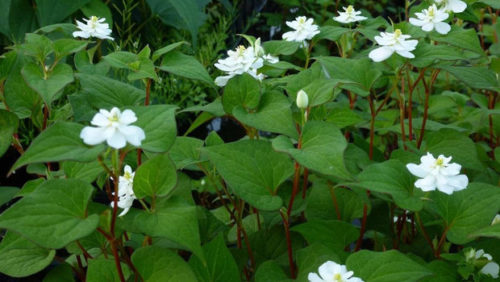
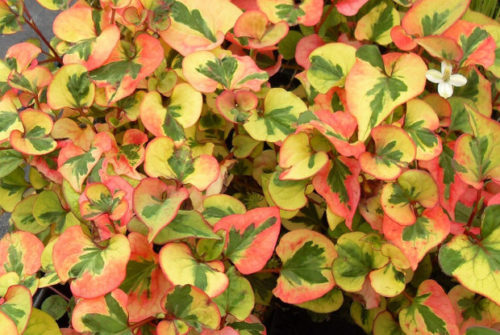
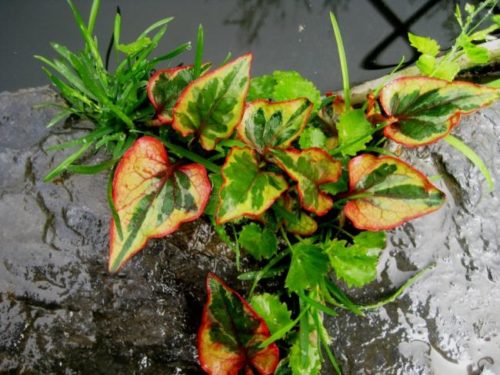
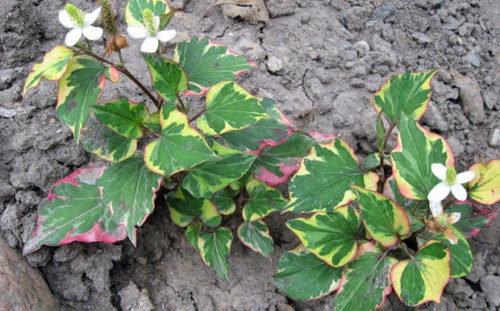
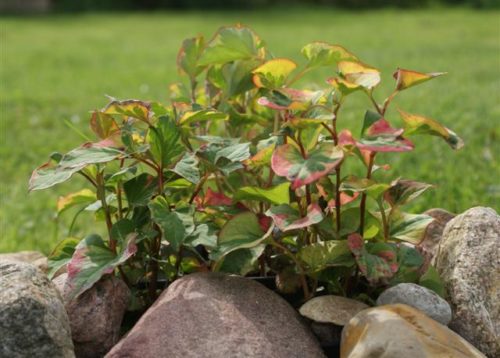
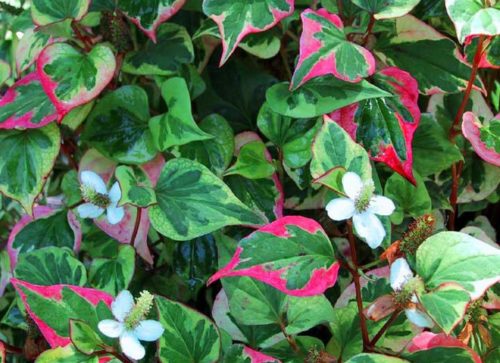
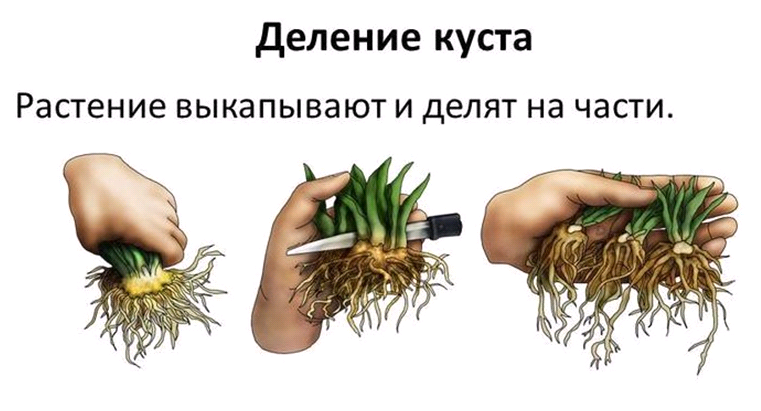
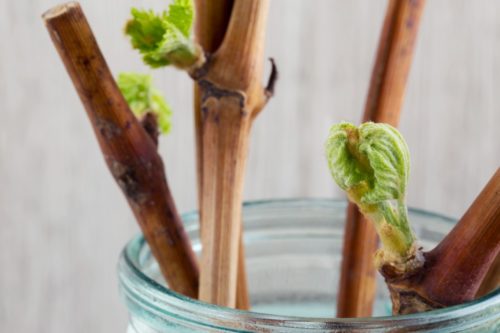
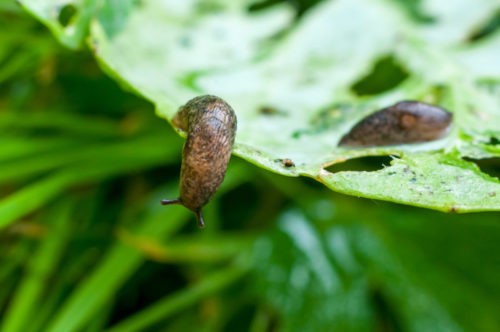
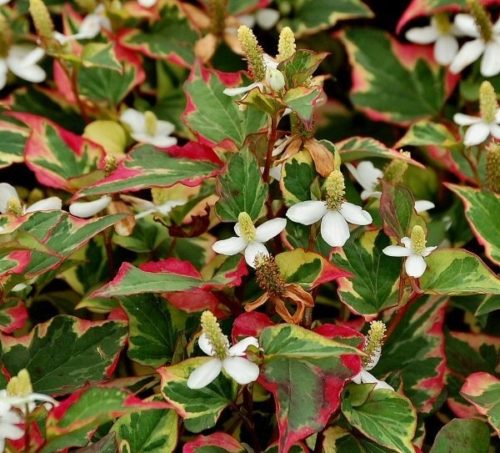

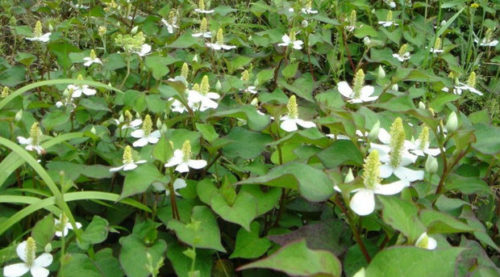

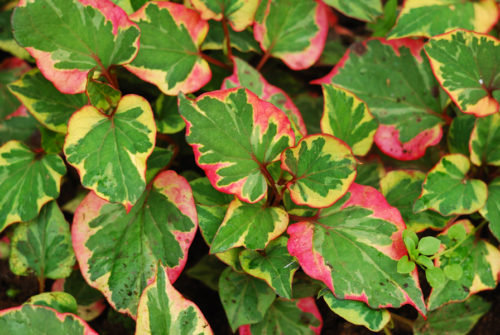
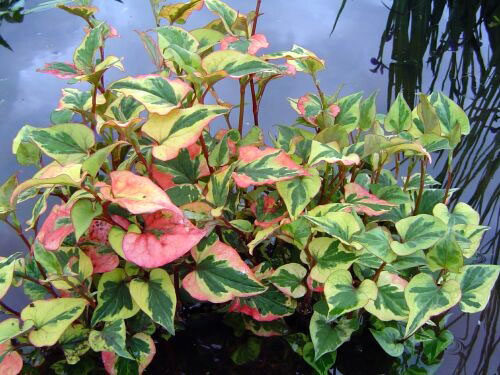












 Start a discussion ...
Start a discussion ...